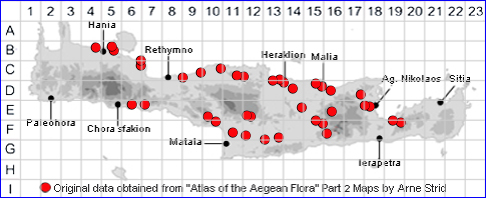
HELIOTROPIUM HIRSUTISSIMUM
Family:- BORAGINACEAE/H. EUROPAEUM Group
Common Names:- None
Synonyms:- None
Meaning:- Heliotropium (Gr) Turn-with-the-sun.
Hirsutissimum (L) Very hairy, hairiest.
Stems:-
a) up to 40 cm.
b) erect or ascending.
c) stems and petioles with dense, greyish or yellowish, spreading (patent) hairs
c.1 mm.
Leaves:-
1) Lamina:
a) up to 5·5 x 2·8 cm.
b) ovate to elliptical, wedge-shaped (cuneate) to rounded at the base, rounded to
almost sharp (subacute) at the apex.
c) covered in soft hairs that are close to the stem (appressed-pubescent).
d) stalk (petiole) up to 3·5 cm.
Flowers:-
a) scented.
1) Sepals:
a) 3-4 mm.
b) linear-oblong.
c) with dense, patent hairs.
2) Corolla:
a) 5-8 mm.
b) limb 4-8 mm diam, white. with 5 scales in the throat.
c) anthers inserted near the base of the corolla-tube.
d) Stigma shallowly hemispherical, wider than long, pubescent.
Fruit:-
1) Nutlets:
a) splitting into 4.
b) hairless (glabrous).
Key features:-
1) Calyx lobed to the base, not concealing the 4 free nutlets, and persisting after
they fall.
2) Stems densely covered with long, shaggy hairs (villous).
3) Corolla with scales in the throat.
Habitat:- Dry, open habitats, especially in cultivated ground or sandy soils. 0-800
m.
Distribution:- Rare in W Greece and lacking in most of the north Widespread in the
E Mediterranean region, introduced as a weed elsewhere. Fairly widespread though
not overly common on Crete.
Flowering time:- End of May to Oct.
Photos by:- Fotis Samaritakis
SPECIES DESCRIPTION
